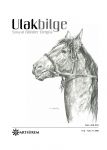VAROLUŞÇULUK FELSEFESİNİN HEYKEL SANATINDAKİ ETKİSİ
EXISTENTIALISM REFLECTION TO SCULPTURE ART
Author(s): Bayram DedeSubject(s): Visual Arts, Aesthetics, Existentialism, Sociology of Art
Published by: Sanat ve Dil Araştırmaları Enstitüsü
Keywords: Existentialism; Philosophy; Statue;
Summary/Abstract: Existentialism is one of the most important movements of thought in the twentieth century. Existentialist thought that centered on human imagery, is still maintained even today. This movement which influences many part of life, even in nowadays confronts us everywhere in life. Existentialist themes will be processed until human exist. While existentialism denies all history, it doesn't appoint its position in future. It goes between being and non-being under the pressure of the idea that human's position in space and time is a just coincidence. Spiritual possibilities which it have, open the door of depression instead of being guide to it. It has lost in the mist of despair, and notion of making a sense of life remains in suspense. While existentialism mentions a dumped to the world and despair of human, it doesn't put in order uncertain function and position of an entity. Individual who gets lonely, walks in dark cloisters where individual is weak, disconnected to history, desperate. Individual always tries to understand him/herself in nature and in the world. Whilst existentialism takes effect in literature and philosophy, is it also effective in sculpture art? These effects and their dimensions constitute the purpose of this study. To find these effects makes easier to trace, to understand, and to interrogate literary and philosophical reflections.
Journal: Ulakbilge Sosyal Bilimler Dergisi
- Issue Year: 6/2018
- Issue No: 24
- Page Range: 571-584
- Page Count: 14
- Language: Turkish

